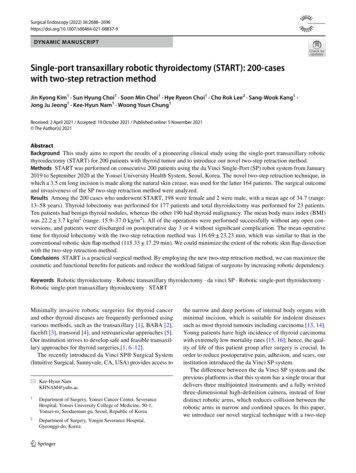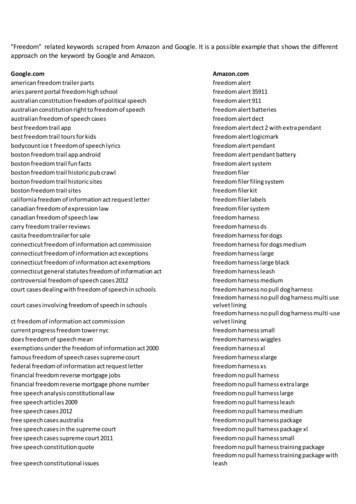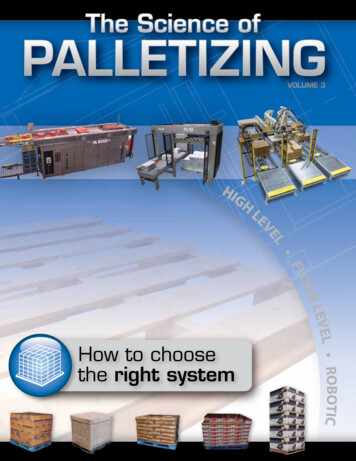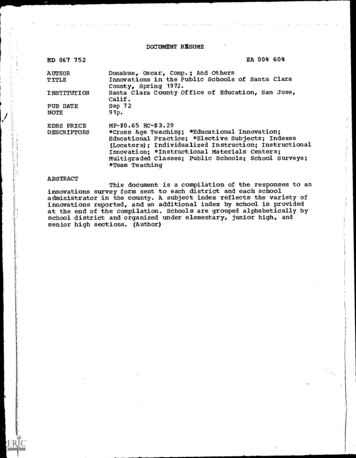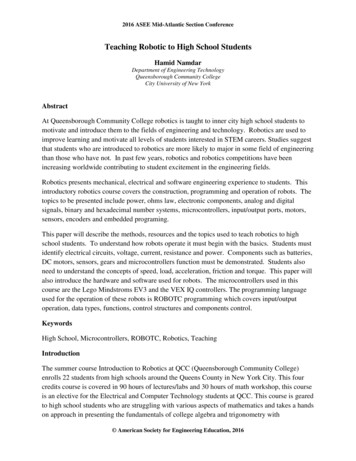
Transcription
2016 ASEE Mid-Atlantic Section ConferenceTeaching Robotic to High School StudentsHamid NamdarDepartment of Engineering TechnologyQueensborough Community CollegeCity University of New YorkAbstractAt Queensborough Community College robotics is taught to inner city high school students tomotivate and introduce them to the fields of engineering and technology. Robotics are used toimprove learning and motivate all levels of students interested in STEM careers. Studies suggestthat students who are introduced to robotics are more likely to major in some field of engineeringthan those who have not. In past few years, robotics and robotics competitions have beenincreasing worldwide contributing to student excitement in the engineering fields.Robotics presents mechanical, electrical and software engineering experience to students. Thisintroductory robotics course covers the construction, programming and operation of robots. Thetopics to be presented include power, ohms law, electronic components, analog and digitalsignals, binary and hexadecimal number systems, microcontrollers, input/output ports, motors,sensors, encoders and embedded programing.This paper will describe the methods, resources and the topics used to teach robotics to highschool students. To understand how robots operate it must begin with the basics. Students mustidentify electrical circuits, voltage, current, resistance and power. Components such as batteries,DC motors, sensors, gears and microcontrollers function must be demonstrated. Students alsoneed to understand the concepts of speed, load, acceleration, friction and torque. This paper willalso introduce the hardware and software used for robots. The microcontrollers used in thiscourse are the Lego Mindstroms EV3 and the VEX IQ controllers. The programming languageused for the operation of these robots is ROBOTC programming which covers input/outputoperation, data types, functions, control structures and components control.KeywordsHigh School, Microcontrollers, ROBOTC, Robotics, TeachingIntroductionThe summer course Introduction to Robotics at QCC (Queensborough Community College)enrolls 22 students from high schools around the Queens County in New York City. This fourcredits course is covered in 90 hours of lectures/labs and 30 hours of math workshop, this courseis an elective for the Electrical and Computer Technology students at QCC. This course is gearedto high school students who are struggling with various aspects of mathematics and takes a handson approach in presenting the fundamentals of college algebra and trigonometry with American Society for Engineering Education, 2016
2016 ASEE Mid-Atlantic Section Conferenceengineering applications. A robotic course should provide the opportunity for high schoolstudents to learn a programming language and exploit concepts which are used in collegecomputer programming, physics and math courses as well as in industry applications.A course in robotics should be designed to introduce robot construction, programming, operationand basic theory of analog and digital electronics to the students. Topics covered in this courseare voltage, current, power, analog and digital signals, electronic and digital components, motors,sensors, microcontrollers, binary and hexadecimal numbers, rotation, speed, torque, encoders andC-like programming. The robotics course give the high school students the opportunity to workin teams to build EV3 and VEX robots from scratch using the microcontrollers, motors, sensorsand the many construction building parts.ObjectivesThe goals for a course in robotics for high school students should be for them to describe theconcepts of Ohm’s law, Watt’s law, electronic components and circuits, binary and hexadecimalnumbers, analog and digital signals for robots. Describe the functions and purpose of roboticscomponents like microcontroller, input/output ports, memory, sensors, motors and the use ofsoftware to program a robot for autonomous maneuvers. Students should use varying structuresand components to build, program and test a robot. Furthermore students should learn to workeffectively as a team, practice project leadership, interpersonal skills and conflict resolution in aclassroom environment. Other objectives for students include are problem solving via theplanning, organization and delivery of projects in robotics.TopicsA robotics course should start by introducing to the high school students the concept of electricalcircuits. Students must learn about what is voltage, current, resistance, Ohm’s law (V I*R) andthe Watt’s law (P V * I). They should be familiar with series, parallel and series-parallel circuitin order to comprehend how robot motors and sensors receive or transmit power and signals forits operation. Electrical components like battery, inductors, capacitors, diodes, LED’s, andtransistors should be introduced, likewise digital signal and digital circuit with gates should bepart of this course for the purpose of controlling and programming a robot. In laboratory studentswould construct electronic circuits using the above components and measure resistance, voltagesand currents using a digital multi-meter. Students should also know the color code to determinethe resistors value. At QCC we use Multisim circuit simulation program to teach the operation ofmany electronic components in electronic circuits. An example would be a LED-resistor seriescircuit shown in figure 1. In this exercise students build the circuit on a breadboard and measurethe voltages and currents of each components to decide if Ohm’s law and Kirchhoff’s voltagelaw is fulfilled. American Society for Engineering Education, 2016
2016 ASEE Mid-Atlantic Section Conference VrR1.5k Ω Vs9VD1N 4007VdFigure 1- LED-Resistor Series CircuitOther topics included in the robotic course are the series RC circuit containing a resistor and acapacitor, characteristics of transistors and SPDT switches, bipolar junction transistor invertingswitching circuit (figure 2) and transistor active region biasing circuit. Students need to knowhow transistors function in order to learn how some of the sensors for robots work. Functiongenerator and oscilloscope are test equipment students should learn to use in the lab to runexperiments on the switching circuit below.Vcc 5 VRC1.5k ΩV o utS P D T S witc hV inRB2N 440147k ΩFigure 2-Bipolar Junction Transistor Inverting Switching CircuitStudents should know about binary and hexadecimal number systems, memory, address bus anddata bus, input/output ports and microcontroller the main part of a robotics system. These topicswill help students understand and code programs for the operation of a robot. American Society for Engineering Education, 2016
2016 ASEE Mid-Atlantic Section ConferenceWhen teaching about motors like continuous rotation motors and servomotors, you shouldinclude speed and torque relationship, no loud speed, stall torque, rotational inertia, gears, motorencoders, motor driver circuits like unidirectional and bidirectional H-bridge circuit and motorspeed control using PWM (pulse width modulation). Additional topics included in this course arevaries sensors like touch, infrared, color, ultrasonic range finding sensor or sonar sensor, gyro,bumper switch and limit switch sensor. These sensors are used in robots for different purposes,for example the sonar sensor is used for a robot to avoid obstacle, the color sensor is used by therobot for color detection or line following and the touch or bumper switch is used evade walls orother objects when the robot gets close to it.Lego EV3The Lego EV3 robot set comes with a controller with eight ports, four ports used for motors andthe other four used for sensors which can be coded using ROBOTC programming language. Thisbrick like computer is used to control motors and collect data from sensors to accomplish a task.This set includes many Lego parts to build, program and test different forms of robotics system.Other components included in this set are three servomotors, ultrasonic sensor, gyro, color andtwo touch sensors.VEX IQThe VEX IQ set comes with a robot brain with twelve smart ports for either motors or sensorsand a remote controller. VEX IQ parts are plastic snap together robotics system which comeswith many structure and motion components including wheels, beams, plates, gears, connectors,pens and shafts. This set also has four smart motors, gyro, distance, color sensors and two oftouch LED and bumper switch plus cables for all the devices. VEX IQ brain can also beprogrammed using ROBOTC programming language.ROBOTCA program is a set of instructions loaded into the memory of a computer or a robot to accomplisha task or solve a problem. The task could be as simple as adding two numbers or as complex ashaving a robot move safely through a field of obstacles. A programmer is responsible foridentifying the task, design a solution and write the code of the program. Programs can bewritten in many languages. Today most programs are written in high-level languages like C ,JavaScript, Visual Basic or HTML. For each program language you need an application programor a complier to convert the high-level code into a machine code (binary 0 and 1) so the CPU(microprocessor) could process the program. The CPU’s job is to fetch, decode and execute theinstructions from the memory until the end of the program.Note that a robot only follows the program you load on its memory, it does not think for itself.The robot can be no smarter than the program that the human programmer gave it. You, as American Society for Engineering Education, 2016
2016 ASEE Mid-Atlantic Section Conferenceprogrammer, will be responsible for planning and describing to the robot exactly what it needs todo to accomplish its task.In this paper you will be introduce to a programming language called ROBOTC. Writing codesto maneuver a robot is an important part of robotic course. ROBOTC is written for differentplatforms like Lego, VEX, and Arduino microcontrollers. ROBOTC is a powerful C-basedprogramming language for a Windows environment for writing and debugging programs, and theonly programming language at this level that offers a comprehensive, real-time debugger.ROBOTC is a cross-platform solution that allows you to learn the type of C-based programmingused in advanced education and professional applications.Rules of programming in ROBOTCROBOTC is a text-based programming language based on the standard C programminglanguage. Commands to the robot are written as text on the screen, processed by the ROBOTCcompiler into a machine language file, and then loaded onto the robot, where they can beexecute. Capitalization is important to the computer. Replacing a lowercase letter with anuppercase letter or an uppercase letter with lowercase will cause an error. The most basic kind ofstatement in ROBOTC simply gives a command to the robot.For examplemotor [ motorA ] 50;// run motorA at 50% powerStatements in ROBOTC are executed in order, as quickly as the CPU of the robot is able to reachthem. Spaces, tabs, and line breaks are generally unimportant in ROBOTC. Every statement endswith a semicolon. It’s like the period at the end of a sentence. Punctuation pairs, like theparentheses and square bracket are used to mark off special areas of code. Every punctuation pairconsists of an “opening” punctuation mark and a “closing” punctuation mark. Simple statementscan only run one after another in order, but control statements allow the program to choose theorder that statements are run. For instance, they may choose between two different groups ofstatements and only run one of them, or sometimes they might repeat a group of statements overand over.Program 1 is an example of a display routine in ROBOTC.//program 1- hello worldtask main ( ){displayTextLine(0, " Hello World ");wait1Msec(10000);}// Display the text on line 0 of 8 on the LCD// Wait for 10 second American Society for Engineering Education, 2016
2016 ASEE Mid-Atlantic Section ConferenceProgram 2 as an example of adding two numbers and display the result.//program 2- add 2 numberstask main( ){int x 5;int y 10;int sum;sum x y;displayTextLine (1, "x %d", x);displayTextLine (2, "y %d ", y);displayTextLine (3, "sum %d", sum);while(true){sleep(10);}}//Display the sum on the screen.// An infinite loop to keep the program running until you terminate itProgram 3-uses the sonar sensor to move the robot while avoiding obstaclestask main(){//While distance sensor is more than 100mm (10cm) awaywhile(getDistanceValue(distanceSensor) 100){setMotorSpeed(leftMotor, 50);//Move left motor at 50% speedsetMotorSpeed(rightMotor, 50); //Move right motor at 50% speed}setMotorSpeed(leftMotor, 0);//Move left motor at 0% speedsetMotorSpeed(rightMotor, 50); //Move right motor at 50% speedwait1Msec(1000);}Since teaching the robotics course to high school students in past four summers, we have noticedsome of the students from the robotics class are attending QCC and majoring in the field ofengineering or technology. The ambition of offering this course was to get students interested inthe STEM curriculum. We attempt to give the students the opportunity to observe whatengineering and technology is all about. Most of the class time was spend on building, American Society for Engineering Education, 2016
2016 ASEE Mid-Atlantic Section Conferenceprogramming, testing and learning about robots by assigning good amount of projects bothindividually and in groups. You must keep the students occupied and attentive in the classroomby introducing fundamental, fresh and stimulating projects. Every lab introduced a newperformance for the robot using either Lago EV3 or Vax IQ. We had students write programs tomove the robot in a triangle or figure eight path. Other programming projects included wereobstacle avoidance, maze, random roaming, wall following, color detection, multicolor linefollower and object manipulation and transportation. As the course progresses we try tointroduce the latest robot technology and improve the subjects in the course.References123ROBOTC, Robomatter, Inc., Carnegie Mellon Robotics Academy, www.robotc.netLego MindstormsEV3, Lego group, education.lego.comVex IQ, Innovation First International Inc, www.vexrobotics.com/vexiq/Hamid Namdar, Associate Professor, Department of Engineering TechnologyQueensborough Community College, City University of New York American Society for Engineering Education, 2016
Rules of programming in ROBOTC ROBOTC is a text-based programming language based on the standard C programming language. Commands to the robot are written as text on the screen, processed by the ROBOTC compiler into a machine language file, and then loaded onto the robot, where they can be execute. Capitalization is important to the computer.






